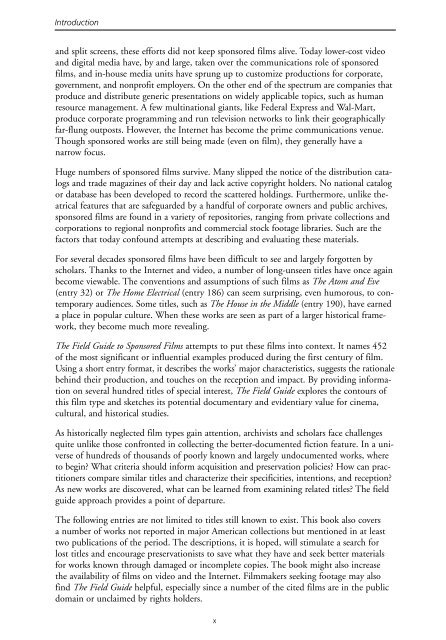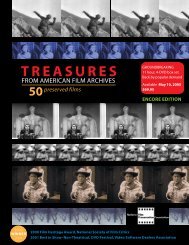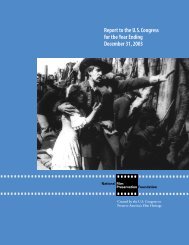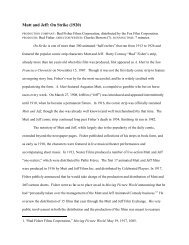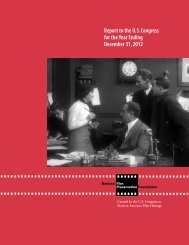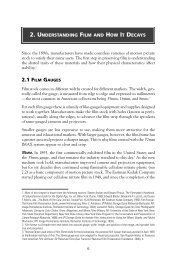Field Guide to Sponsored Films - National Film Preservation ...
Field Guide to Sponsored Films - National Film Preservation ...
Field Guide to Sponsored Films - National Film Preservation ...
Create successful ePaper yourself
Turn your PDF publications into a flip-book with our unique Google optimized e-Paper software.
Introduction<br />
and split screens, these efforts did not keep sponsored films alive. Today lower-cost video<br />
and digital media have, by and large, taken over the communications role of sponsored<br />
films, and in-house media units have sprung up <strong>to</strong> cus<strong>to</strong>mize productions for corporate,<br />
government, and nonprofit employers. On the other end of the spectrum are companies that<br />
produce and distribute generic presentations on widely applicable <strong>to</strong>pics, such as human<br />
resource management. A few multinational giants, like Federal Express and Wal-Mart,<br />
produce corporate programming and run television networks <strong>to</strong> link their geographically<br />
far-flung outposts. However, the Internet has become the prime communications venue.<br />
Though sponsored works are still being made (even on film), they generally have a<br />
narrow focus.<br />
Huge numbers of sponsored films survive. Many slipped the notice of the distribution catalogs<br />
and trade magazines of their day and lack active copyright holders. No national catalog<br />
or database has been developed <strong>to</strong> record the scattered holdings. Furthermore, unlike theatrical<br />
features that are safeguarded by a handful of corporate owners and public archives,<br />
sponsored films are found in a variety of reposi<strong>to</strong>ries, ranging from private collections and<br />
corporations <strong>to</strong> regional nonprofits and commercial s<strong>to</strong>ck footage libraries. Such are the<br />
fac<strong>to</strong>rs that <strong>to</strong>day confound attempts at describing and evaluating these materials.<br />
For several decades sponsored films have been difficult <strong>to</strong> see and largely forgotten by<br />
scholars. Thanks <strong>to</strong> the Internet and video, a number of long-unseen titles have once again<br />
become viewable. The conventions and assumptions of such films as The A<strong>to</strong>m and Eve<br />
(entry 32) or The Home Electrical (entry 186) can seem surprising, even humorous, <strong>to</strong> contemporary<br />
audiences. Some titles, such as The House in the Middle (entry 190), have earned<br />
a place in popular culture. When these works are seen as part of a larger his<strong>to</strong>rical framework,<br />
they become much more revealing.<br />
The <strong>Field</strong> <strong>Guide</strong> <strong>to</strong> <strong>Sponsored</strong> <strong><strong>Film</strong>s</strong> attempts <strong>to</strong> put these films in<strong>to</strong> context. It names 452<br />
of the most significant or influential examples produced during the first century of film.<br />
Using a short entry format, it describes the works’ major characteristics, suggests the rationale<br />
behind their production, and <strong>to</strong>uches on the reception and impact. By providing information<br />
on several hundred titles of special interest, The <strong>Field</strong> <strong>Guide</strong> explores the con<strong>to</strong>urs of<br />
this film type and sketches its potential documentary and evidentiary value for cinema,<br />
cultural, and his<strong>to</strong>rical studies.<br />
As his<strong>to</strong>rically neglected film types gain attention, archivists and scholars face challenges<br />
quite unlike those confronted in collecting the better-documented fiction feature. In a universe<br />
of hundreds of thousands of poorly known and largely undocumented works, where<br />
<strong>to</strong> begin? What criteria should inform acquisition and preservation policies? How can practitioners<br />
compare similar titles and characterize their specificities, intentions, and reception?<br />
As new works are discovered, what can be learned from examining related titles? The field<br />
guide approach provides a point of departure.<br />
The following entries are not limited <strong>to</strong> titles still known <strong>to</strong> exist. This book also covers<br />
a number of works not reported in major American collections but mentioned in at least<br />
two publications of the period. The descriptions, it is hoped, will stimulate a search for<br />
lost titles and encourage preservationists <strong>to</strong> save what they have and seek better materials<br />
for works known through damaged or incomplete copies. The book might also increase<br />
the availability of films on video and the Internet. <strong>Film</strong>makers seeking footage may also<br />
find The <strong>Field</strong> <strong>Guide</strong> helpful, especially since a number of the cited films are in the public<br />
domain or unclaimed by rights holders.<br />
x


